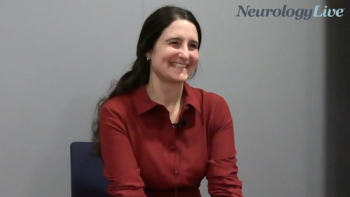
- New Directions and Practice Impacting Recommendations in Multiple Sclerosis
The Role of Biomarkers in Multiple Sclerosis
Sensitive biomarkers for multiple sclerosis (MS) can help improve diagnosis, predict disease activity (eg, relapse activity or progression), and assess treatment response; however, identifying useful biomarkers for MS has been difficult due in part to the high heterogeneity of the disease and variation in immune signatures among patients.1 Several blood- and magnetic resonance imaging (MRI)-based biomarkers are in late stages of development. Clinically useful biomarkers will be noninvasive, easy to obtain, accurate, reproducible, and cost effective.1
Fluid Biomarkers
Neurofilament Light Chain
Neurofilament light chain (NfL) is a neuron-specific cytoskeletal protein that increases in the blood with any neuroaxonal injury. High serum and/or cerebrospinal fluid (CSF) levels have been linked with higher T2 lesion load and greater number of gadolinium-enhancing T1 lesions in relapsing-remitting MS ([RMSS] of note, concentrations also rise with other diseases affecting the neuroaxonal compartment).2,3 Additionally, higher serum NfL (sNfL) levels were associated with a greater number of new or enlarging T2 lesions, loss of brain volume, and risk for confirmed disability worsening over a 1- to 2-year period.3 sNfL is reduced by effective treatment, with lower sNfL concentrations observed 6 and 24 months after starting treatment with fingolimod and significant, durable reductions in sNfL concentrations observed in patients with RRMS and primary progressive MS (PPMS) who received ocrelizumab.2 After suppression of disease activity with ocrelizumab, a persistently high on-treatment NfL level at 48 weeks was associated with an increased risk for long-term disability progression and an approximately 2-fold increased likelihood of confirmed disability progression over approximately 8 years.2 sNfL is therefore a leading serologic biomarker for evaluating MS disease activity. sNfL appears to measure a combination of inflammatory disease biology as well as slowly progressive neurodegeneration.
The sNfL values increase with age and decrease with higher body mass index (BMI); therefore, adjusted normal ranges are needed.4 Additionally, several platforms are available for quantifying sNfL, and while results are tightly correlated between the platforms, the absolute values returned can vary depending on the platform used. Based on large reference datasets, cross-sectional interpretation of the degree of abnormality of sNfL levels as compared to those of controls is informative and supplemented by following individual patient trends over time (using a consistent testing platform).
As sNfL measurements are incorporated into clinical practice, understanding the kinetics of change in sNfL values with disease activity and treatment will help determine the appropriate frequency for measuring this biomarker and the degree to which changes in or levels of normalization for sNfL represent an actionable item. In evaluating a 3-parameter end point for no evidence of disease activity, patients' increased sNfL levels were prognostic of disease activity in the following year.⁴ High sNfL values while on disease-modifying therapy reflect ongoing neuroaxonal injury and an insufficient response to treatment, likely indicating that treatment should be changed if other relevant comorbidities (eg, at least moderately severe renal impairment or insufficiently controlled diabetes) have been excluded.
Octave Panels
The Octave panel is a first-in-class, multiprotein, serum-based assay for assessment of disease activity in MS.5 The panel includes 18 serum biomarkers that were selected based on research and development studies and included into an algorithm that calculates 4 disease pathway scores (immunomodulation, neuroinflammation, myelin biology, and neuroaxonal integrity).5 In a clinical validation study, the scores on this 18-protein, serum-based assay were strongly associated with the presence of T1 gadolinium-enhancing lesions, new or enlarging T2 lesions, and active vs stable disease, and the model performed better than the single-protein model based on demographically corrected NfL.5 However, combining multiple biomarkers into a single score may eliminate the nuance of the multidimensional pathologic components involved in MS progression. Additionally, many of the correlations between Octave scores and disease indices appear to be driven by 3 to 4 of the markers (primarily NfL), and the added value of the remaining biomarkers appear to be relatively small with a lack of data on how to use the information.
For other markers, it is not clear how useful the serum measurements are; for example, while CSF levels of CXCL13 have been promising as an MS biomarker, serum CXCL13 levels are much higher and likely indicate general systemic inflammation rather than the central nervous system (CNS)-specific inflammation that is more relevant to MS. Some neurologists use the Octave panel as a 1-time test, because it is accessible and relatively inexpensive and provides a snapshot of the patient’s disease status, but understanding how to interpret and use the test to guide clinical decision-making is still evolving.
Imaging Biomarkers
Central Vein Sign
The central vein sign (CVS) was first identified on ultra high‑field MRI; it is defined radiologically as a hypointense vessel located in the middle of an MS lesion with a diameter of greater than 3 mm and pathologically as a perivenular, inflammatory, demyelinated focal lesion.6-8 Because the location of this vein in the lesion is highly specific to MS, it has been proposed as an imaging biomarker to differentiate MS from other CNS conditions with white matter lesions.6 The CVS is also common in patients along the MS spectrum, including those with clinically isolated syndrome (CIS)9 and radiologically isolated syndrome (RIS).10 Two prospective trials evaluating CVS as a diagnostic tool are ongoing: the DECISIve trial (NCT04024969) is comparing the diagnostic accuracy between CVS on T2-weighted MRI and lumbar puncture with oligoclonal band examination in patients presenting with possible MS, and the CAVS-MS trial (NCT04495556) is evaluating the agreement between CVS and McDonald criteria for diagnosis of MS, the sensitivity of CVS to identify MS in patients with typical presentations, and the specificity of CVS for patients with atypical presentations.11,12
CVS may be useful for monitoring disease if it helps to distinguish inflammatory lesions related to MS from those caused by other conditions. It may also help avoid MS misdiagnosis. At present, the utility of this tool is limited by heterogeneity in MRI scanners and sequence acquisition protocols, and the degree to which these variables affect the readout should be elucidated in future research.6 Tailoring the MRI to maximize specificity (as opposed to sensitivity) can help optimize the clinical utility of the CVS as a biomarker. Presently, high resolution T2* relaxation with 3-dimensional echo-planar imaging may represent the optimal sequence for detecting CVS, but this is not widely available on clinical MRI scanners. Susceptible weighted-imaging protocols can also reveal a subset of CVS lesions.
Paramagnetic Rim Lesions
Paramagnetic rim lesions (PRLs) are defined radiologically as persistently hyperintense MRI lesions with a surrounding hypointense rim and pathologically as chronically active lesions with iron accumulation in microglia and macrophages at the edge of the demyelinated area.13,14 PRLs have been correlated with CSF markers of neurodegeneration, including higher age-adjusted NfL percentiles and optical coherence tomography parameters (eg, lower peripapillary retinal nerve fiber layer and ganglion cell-inner plexiform layer thicknesses).13,15
PRLs are present across the spectrum of MS and in all age groups. High numbers of PRLs appear to be correlated with more aggressive disease, positioning PRLs as a promising imaging biomarker. Optimizing and standardizing the image quality, protocols, and algorithms will be important to effectively use this biomarker in the clinical setting. Communication between neurologists and radiologists about optimal image parameters and protocols is also important for improving the utility of this biomarker.
Slowly Expanding Lesions
Slowly expanding lesions (SELs), which are radiologically defined as gradual and constant radial expansion of T2 lesions for at least 3 time points, may be more prevalent than PRL in patients with MS (92% with SEL vs 56% with PRL in 1 retrospective study), and higher SEL counts have been correlated with greater increases in Expanded Disability Status Scale (EDSS) scores over time. The EDSS measures disability on a scale of 0 to 10, with a higher score indicating greater disability.16,17 Additionally, presence of both SELs and PRLs was associated with worsening disability over time compared with detection of SEL alone.17 This finding could be useful for predicting future disease severity, although the SEL designation is currently based on a mathematical construct—rather than a pathologic mechanism—and further characterization of the pathologic relevance of the SEL finding will be helpful for refining the SEL definition. The reliance on computational algorithms to detect SELs also limits the clinical applicability, at least in current practice. A recent federal research grant (DOD W81XWH-21-1-0787) was awarded to to investigators at the Cleveland Clinic to study the pathology of SEL in MS.
Conclusions
Advances have been made in the search for MS biomarkers that predict MS relapse and disability progression, but it is unlikely that any single measure can comprehensively evaluate patients with MS because of the complexity of the disease and high heterogeneity in disease behavior.1 Additionally, the MRI protocols and computational tools used to measure image-based biomarkers are largely unstandardized, and future work is needed to standardize these protocols, train algorithms to adjust for technical differences across MRI platforms, and retrain those who use them as the technology evolves. Using rational combinations of biomarkers that reflect the diversity of MS pathology will help optimize the diagnostic and prognostic value of these measures.1
Faculty presenters: Jens Kuhle, MD, PhD; and Pascal Sati, PhD. This article was reviewed, edited, and approved by Dr Kuhle, Dr Sati, and Dr Longbrake.
REFERENCES
1. Yang J, Hamade M, Wu Q, Wang Q, Axtell R, Giri S, Mao-Draayer Y. Current and Future Biomarkers in Multiple Sclerosis. Int J Mol Sci. 2022 May 24;23(11):5877. doi:10.3390/ijms23115877. PMID: 35682558; PMCID: PMC9180348.
2. Bar-Or A, Thanei G-A, Harp C, et al. Blood Neurofilament Light Levels Predict Non-Relapsing Progression Following Anti-CD20 Therapy in Relapsing and Primary Progressive Multiple Sclerosis: Findings From the Ocrelizumab Randomized, Double-Blind Phase 3 Clinical Trials. Poster presented at the 38th Congress of the European Committee for Treatment and Research in Multiple Sclerosis (ECTRIMS); Amsterdam, The Netherlands and virtual. October 26-28, 2022. Abstract P256.
3. Kuhle J, Kropshofer H, Haering DA, et al. Blood neurofilament light chain as a biomarker of MS disease activity and treatment response. Neurology. 2019;92(10):e1007-e1015. doi:10.1212/WNL.0000000000007032
4. Benkert P, Meier S, Schaedelin S, et al. Serum neurofilament light chain for individual prognostication of disease activity in people with multiple sclerosis: a retrospective modelling and validation study. Lancet Neurol. 2022;21(3):246-257. doi:10.1016/S1474-4422(22)00009-6
5. Chitnis T, Foley J, Ionete C, et al. Clinical validation of a multi-protein, serum-based assay for disease activity assessments in multiple sclerosis. Clin Immunol. 2023;253:109688. doi:10.1016/j.clim.2023.109688
6. Castellaro M, Tamanti A, Pisani AI, Pizzini FB, Crescenzo F, Calabrese M. The Use of the Central Vein Sign in the Diagnosis of Multiple Sclerosis: A Systematic Review and Meta-analysis. Diagnostics (Basel). 2020;10(12):1025. Published 2020 Nov 29. doi:10.3390/diagnostics10121025
7. Sati P, Oh J, Constable RT, et al. The central vein sign and its clinical evaluation for the diagnosis of multiple sclerosis: a consensus statement from the North American Imaging in Multiple Sclerosis Cooperative. Nat Rev Neurol. 2016;12(12):714-722. doi:10.1038/nrneurol.2016.166
8. Adams CW. The onset and progression of the lesion in multiple sclerosis. J Neurol Sci. 1975;25(2):165-182. doi:10.1016/0022-510x(75)90138-0
9. Clarke MA, Pareto D, Pessini-Ferreira L, et al. Value of 3T Susceptibility-Weighted Imaging in the Diagnosis of Multiple Sclerosis. AJNR Am J Neuroradiol. 2020;41(6):1001-1008. doi:10.3174/ajnr.A6547
10. Suthiphosuwan S, Sati P, Absinta M, et al. Paramagnetic Rim Sign in Radiologically Isolated Syndrome. JAMA Neurol. 2020;77(5):653-655. doi:10.1001/jamaneurol.2020.0124
11. Allen CM, Morgan P, Craner M, et al222 DECISIve – DiagnosE using the Central veIn SIgn. A study comparing T2* MRI and lumbar puncture. JNNP. 2022;93:A77.
12. Ontaneda D, Sati P, Raza P, et al. Central vein sign: A diagnostic biomarker in multiple sclerosis (CAVS-MS) study protocol for a prospective multicenter trial. Neuroimage Clin. 2021;32:102834. doi:10.1016/j.nicl.2021.102834
13. Maggi P, Kuhle J, Schädelin S, et al. Chronic White Matter Inflammation and Serum Neurofilament Levels in Multiple Sclerosis. Neurology. 2021;97(6):e543-e553. doi:10.1212/WNL.0000000000012326
14. Dal-Bianco A, Grabner G, Kronnerwetter C, et al. Slow expansion of multiple sclerosis iron rim lesions: pathology and 7 T magnetic resonance imaging. Acta Neuropathol. 2017;133(1):25-42. doi:10.1007/s00401-016-1636-z
15. Krajnc N, Dal-Bianco A, Leutmezer F, et al. Association of paramagnetic rim lesions and retinal layer thickness in patients with multiple sclerosis. Mult Scler. 2023;29(3):374-384. doi:10.1177/13524585221138486
16. Elliott C, Wolinsky JS, Hauser SL, et al. Slowly expanding/evolving lesions as a magnetic resonance imaging marker of chronic active multiple sclerosis lesions. Mult Scler. 2019;25(14):1915-1925. doi:10.1177/1352458518814117
17. Calvi A, Clarke MA, Prados F, et al. Relationship between paramagnetic rim lesions and slowly expanding lesions in multiple sclerosis. Mult Scler. 2023;29(3):352-362. doi:10.1177/13524585221141964
Articles in this issue
almost 2 years ago
Building Bridges to the Next Advances in Multiple Sclerosis Carealmost 2 years ago
The Changing Paradigm of Multiple Sclerosisalmost 2 years ago
Treating Multiple Sclerosis Throughout the Life Cycle of DiseaseNewsletter
Keep your finger on the pulse of neurology—subscribe to NeurologyLive for expert interviews, new data, and breakthrough treatment updates.




